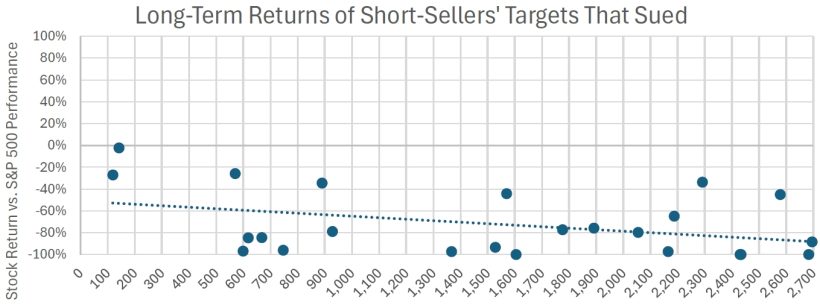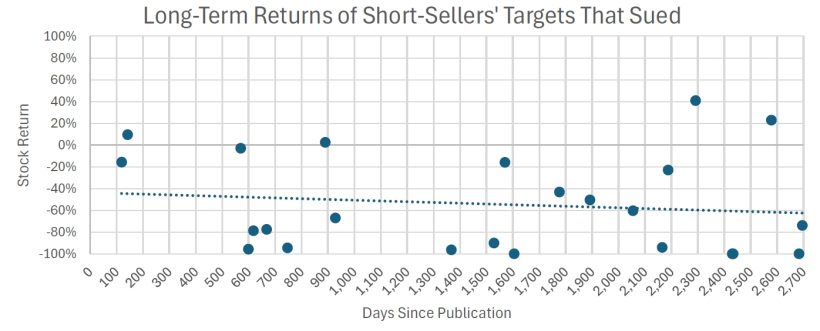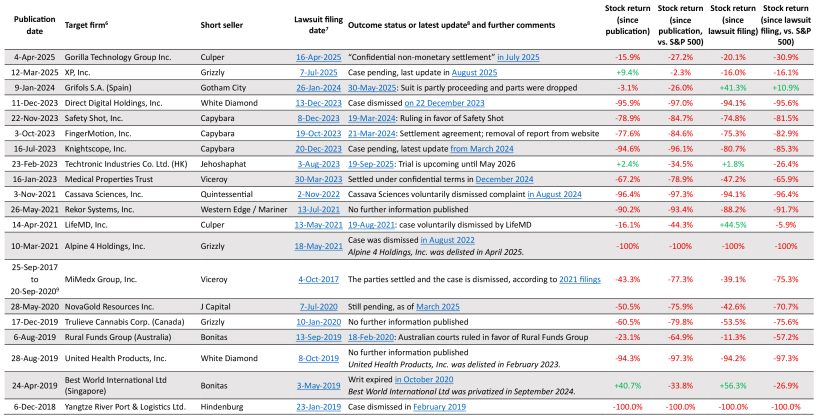Abstract: A previous empirical study by Brendel and Ryans (2021) has shown that stocks of firms that choose litigation to respond to short seller reports exhibit a strong price underperformance in the long run. We present an updated study based on 1,100 short activist publications against 906 target firms from January 1st, 2018, to August 1st, 2025. 24 lawsuits were filed by target firms against the publisher; in all 24 cases, the firm’s share price failed to long-term recover against the S&P 500. Despite (or because) of the lawsuits, the firms’ stock prices averaged a long-term return of -72.0% against the index (and -54.4% in absolute returns) with 21 firms’ stock prices underperforming the S&P 500 by more than 30%, 18 firms by more than 60%, and 12 by more than 80%. Firms that did not sue the short seller performed significantly better, with -29.4% performance against the index and +15.8% in absolute returns. The trend of underperforming stock returns from suing companies continues even years after the publication and lawsuits, and reaches a 80% decline against the index on average at around 6 years after publication. Even if we exclude the period between the report publication and the lawsuit filing, the companies’ long-term returns after the filing of the lawsuit are still extremely bad, underperforming the index by 66.0% long-term from the moment of the lawsuit filing on. These new results, together with the facts that suing firms rarely achieve profitable settlements and firms can refute allegations conveniently without legal filings, provide further support for Brendel and Ryans’ hypothesis that target firms predominantly file lawsuits as a “bluffing strategy.”
1. Introduction
Brendel and Ryans (2021)1 provide an extensive study on listed companies’ reactions after activist short sellers published allegations against a company. They observe 421 publications from 1996 to 2018. Their selection criteria for activist campaigns are that the publisher makes claims of stock overvaluation, entered a short position, publishes online, and published more than one short report in its history.
Only 6% of short attacks in Brendel and Ryans’ sample were followed with a lawsuit or a threat of a lawsuit by the listed company. Double that many companies, 12%, did publish an extra letter or note to investors addressing the short seller’s publication without taking legal action, and 4% launched internal investigations of their own corporation by an outside counsel. Thus, lawsuits against short sellers are rather uncommon.
Brendel and Ryans’ data shows that half of the firms that sued short sellers were later delisted, which implies that firms that turned out to have significantly inflated share prices at the time of a short seller publication are statistically much more likely to sue.

Brendel and Ryans comment, based on previous literature, that
“the firm may respond by suing the short seller for defamation as a bluffing strategy, and if the activist has insufficient financial resources to mount a legal defense, they may be forced to settle by agreeing to retract the report. A litigious target firm also signals to regulators and other short sellers that the firm is an expensive target to pursue, reducing the odds that authorities launch an investigation into the firm’s activities (Dechow et al. [2011], Blackburne et al. [2020]).” (p. 495)
Given the litigation costs for the company, further legal risk from discovery, low potential settlement payments to gain from activists, and the low cost of clarifying false allegations with own publications, lawsuits against activist short sellers seem in almost all cases to function as signals to the market, rather than a strategy to optimize incoming cash flows from litigation activities. Furthermore, the potentially forced retraction of information that was already published online is, as well, only a signal to the market because web scrapers and archive pages duplicated this information and maintain its accessibility.
2. Our New Results
We add to the study by Brendel and Ryans our own statistical analysis based on the database provided by Breakout Point2 for short sellers’ publications from January 1, 2018, to August 1, 2025. Our analysis reflects the newest trends on the matter, and our conclusions are highly consistent with Brendel and Ryans’ findings. The following tables show outcomes in cases where short sellers attacked a company with a negative report, and the attacked company followed with filing a lawsuit3 against the short seller and/or affiliates for defamation, libel, securities fraud or rights infringement. We compare the stock price performance against the S&P 500’s performance until the cut-off date of August 1st, 2025.
From 906 firms targeted by short sellers in a total of 1,100 reports, 24 filed lawsuits (2.6%) against the publisher;4 in all 24 cases, the firm’s share price failed to recover against the S&P 500 performance. Only 4 of 24 firms showed a net positive return since report publication. Despite or because of the lawsuits, 21 of the 24 firms’ stock prices underperformed the S&P 500 by more than 30%, 18 firms by more than 60%, and twelve by more than 80%. Five of the suing firms were delisted from the exchanges or fled for bankruptcy.
Lawsuits were typically filed against established short-selling firms5 like Viceroy (3 lawsuits), Capybara (3 lawsuits), Grizzly (3), Culper (2), and Bonitas (2), but also lesser-known brands were subject to lawsuits. Of the 24 lawsuits, 5 have their outcome still pending, 8 settled or were ruled in favor of the target firm, according to publicly available information, and the rest were dismissed, dropped, abandoned or lacking further public information.


The least squared trendline in figure 1 indicates that the statistically expected outcome for the stock of a suing company is a valuation decline of 80% against the index over the next 6 years (2,192 days) after the publication.
Even if we do not control the long-term stock returns for overall index performance, the large number of stocks of firms that got delisted, filed for bankruptcy or lost the vast majority of their equity valuation cause the least-square trend valuation decline of about 60% against the index over the next 6 years after the publication.

The statistics in table 1 show how strong of an indicator for bad long-term returns the filing of a lawsuit on average is. Even if we exclude the period between the report publication and the lawsuit filing, the companies’ long-term returns after the filing of the lawsuit are still extremely bad. Thus, from the statistical view, traders can use the filing of a lawsuit as a strong negative signal for stock valuation.
These results, based on the introductory discussion above, provide very strong evidence for the hypothesis that defamation lawsuits by short activists’ targets are predominantly filed as a bluffing strategy to signal confidence to investors in circumstances of material issues with the underlying businesses. It seems, the firms’ leadership files a lawsuit to signal confidence in face of critical allegations. The much less costly approach would be to issue an explanatory note to investors directly and refute allegations in a public forum.
Table 2 shows case details. Even lawsuits that resulted in a ruling or settlement in favor of the plaintiff coincide with strongly negative long-term returns. This was the case for Gorilla Technology Group Inc., Safety Shot, Inc., FingerMotion, Inc., Medical Properties Trust, MiMedx Group, Inc., Rural Funds Group, and EBIX, Inc., and Farmland Partners Inc. that all underformed the S&P 500 strongly over the tested horizon. The only noticeable exception is Grifols S.A., a large Spanish legacy healthcare company, who managed to realize a positive return performance after the lawsuit filing.


3. Discussion
Brendel and Ryans hypothesis that defamation lawsuits against short sellers are predominantly a “bluffing strategy” is strongly supported by our empirical findings. Furthermore, our results provide important insights for investors by demonstrating that, from a statistical perspective, a defamation lawsuit constitutes a notably negative signal for the long-term share price perfomance.
Article by Grizzly Research


